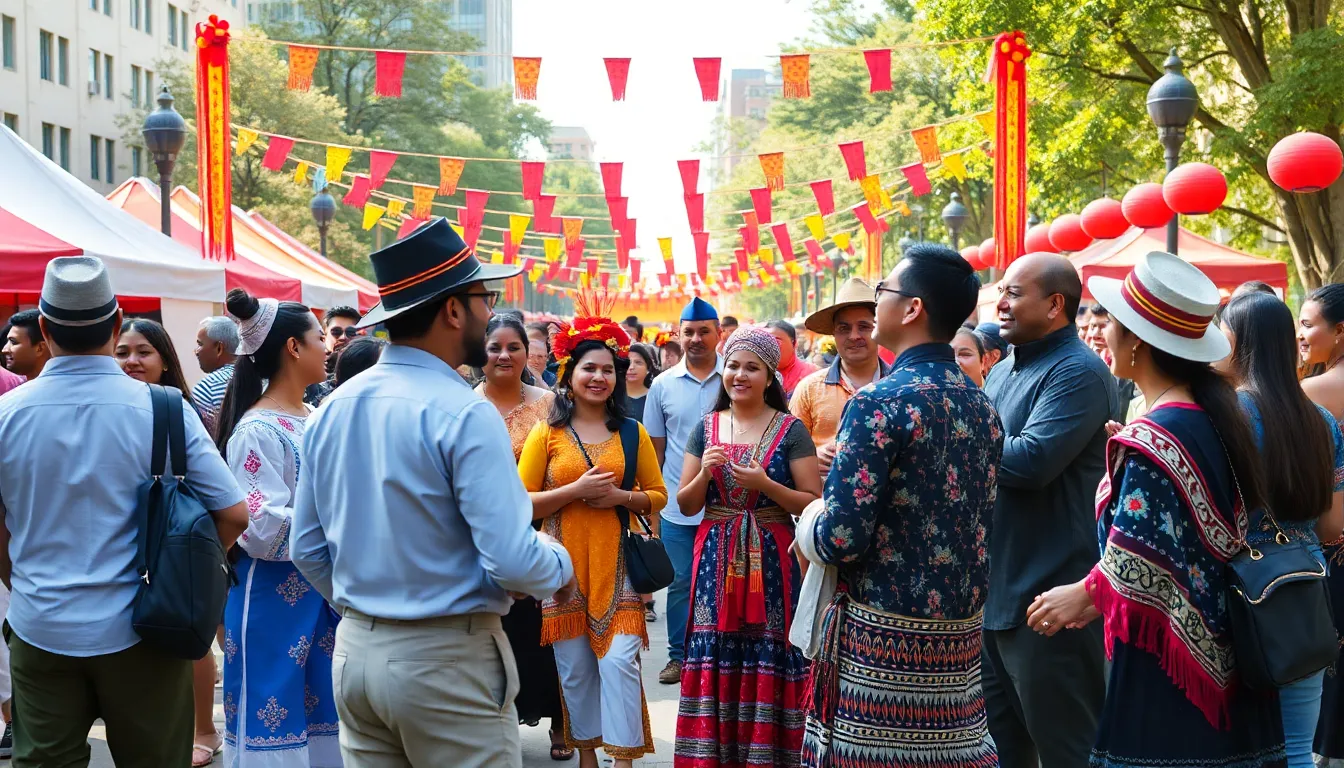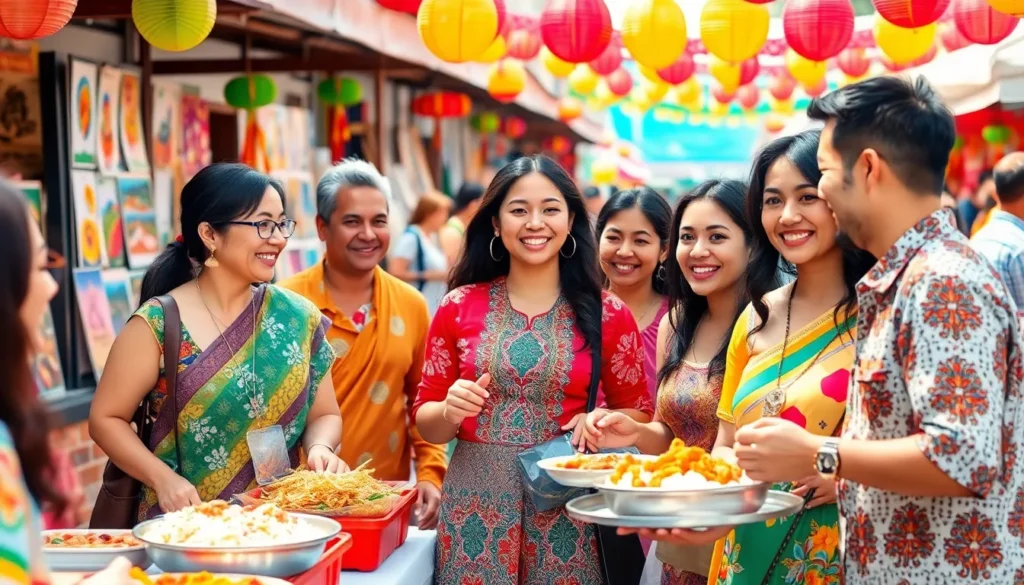Culture is the spice of life, adding flavor to our everyday existence. From quirky traditions to mouthwatering cuisines, it shapes how people interact and express themselves. Ever wondered why some folks dance like nobody’s watching while others prefer a good book? Culture’s got the answers, and it’s more entertaining than a cat video marathon.
Table of Contents
ToggleWhat Is Culture?
Culture encompasses the shared beliefs, values, norms, and practices of a group. It shapes the way people communicate, behave, and interact with their environment. Traditions play a central role in culture, representing the unique historical contexts that define a community.
Language, as an essential component of culture, allows individuals to express themselves and share ideas. It reflects the worldview and thought patterns of a group. Cuisine represents another vibrant aspect of culture, exhibiting regional ingredients and cooking methods that highlight local heritage.
Symbols and rituals often convey deep meanings within a culture. They serve as markers of identity, creating a sense of belonging among individuals. Art, in its various forms, captures cultural narratives and values, offering insight into societal priorities and creativity.
Cultural elements evolve over time through interactions with others and changing circumstances. They convey continuity and adaptation, ensuring relevance in contemporary settings. Music and dance provide avenues for cultural expression, allowing individuals to celebrate heritage while innovating with new styles.
Understanding culture enhances appreciation for diversity. It fosters empathy, demonstrating the richness in differing perspectives. Awareness of cultural differences can promote harmony among various groups. Ultimately, culture influences individual behaviors and societal operations, shaping experiences and understanding of the world.
Importance Of Culture

Culture plays a crucial role in shaping individual identities and fostering connections within society. It provides a framework through which people navigate their lives, influencing behaviors and interactions.
Social Identity
Social identity emerges from shared cultural experiences and values. Individuals often identify with their culture based on language, traditions, and customs. Cultural background influences perceptions and interactions, while fostering pride and belonging in communal activities. Examples include rituals, celebrations, and shared histories that strengthen identity. Group membership reinforces individuals’ sense of self, highlighting how distinct cultures contribute to a richer social framework. This collective identity shapes perspectives and behaviors, guiding how individuals relate to one another.
Community Cohesion
Community cohesion stems from shared cultural understandings and practices. Common traditions and values unite people, creating bonds that strengthen communities. For instance, festivals can bring diverse groups together to celebrate cultural heritage and shared experiences. Language and communication styles also enhance connections, promoting inclusivity and mutual respect. Cultural expressions such as art and music often serve as platforms for collaboration and dialogue. These communal ties lay the foundation for cooperation, leading to enhanced stability and resilience within neighborhoods. Cultivating a sense of community fosters support networks essential for thriving societies.
Types Of Culture
Culture can be categorized into two primary types: material culture and non-material culture. Each type plays a distinct role in shaping societal values and experiences.
Material Culture
Material culture encompasses tangible items that people create and use. It includes objects like clothing, tools, buildings, and artwork. Artifacts represent a society’s history and values, reflecting tastes and technological advancements. For instance, traditional pottery or modern skyscrapers showcase creativity and craftsmanship. Furthermore, material culture influences daily life, from the utensils used in cooking to the design of public spaces. It embodies the practical aspects of culture that people engage with regularly, providing context and a sense of identity.
Non-Material Culture
Non-material culture refers to the intangible aspects of a society’s culture, including beliefs, values, norms, and practices. This type shapes social behaviors and influences emotions. For example, language acts as a primary means of communication, carrying cultural significance. Rituals and customs represent shared traditions that strengthen community bonds. Additionally, norms dictate acceptable behavior, guiding interactions within society. Beliefs surrounding religion or moral values inform ethical decisions and perspectives. Collectively, non-material culture fosters a shared identity, helping individuals connect on emotional and social levels.
Facts About Culture
Culture encompasses a wide range of expressions and dynamics that shape societies. Understanding the intricacies of culture offers valuable insights into human behavior and societal frameworks.
Cultural Diversity
Cultural diversity reflects the variety of human societies and cultures across the globe. It includes differences in language, customs, traditions, and belief systems. Countries celebrate their cultural diversity through festivals and heritage events. Celebrating various cuisines provides a rich tapestry of flavors and cooking techniques. Diverse artistic expressions, such as music and dance, showcase unique cultural narratives. Awareness of cultural diversity promotes empathy and understanding among different groups. Researchers emphasize that exposure to diverse cultures fosters tolerance and reduces biases.
Cultural Evolution
Cultural evolution illustrates how cultures adapt and change over time. Societies respond to technological advancements and global interactions, altering traditions and norms. Historical events often drive significant shifts in cultural practices. For instance, the internet has transformed communication styles and cultural exchanges. Generational dynamics influence the adoption of new ideas and customs while preserving heritage. Continuous interaction between cultures leads to hybrid identities, enriching societies. Scholars note that understanding cultural evolution helps navigate contemporary challenges and appreciate cultural legacies.
How Culture Influences Daily Life
Culture shapes daily life in numerous ways, impacting how individuals interact and express themselves. Communication styles differ across cultures, reflecting unique beliefs and values. For example, some cultures emphasize direct communication, while others value indirect approaches.
Traditions influence daily routines, marking important events through ceremonies and celebrations. Festivals serve as communal gatherings, fostering a sense of connection within communities. In many cultures, language plays a significant role, often acting as a marker of identity and heritage.
Cuisine also reflects cultural influence, showcasing regional ingredients and cooking techniques. Food serves not only as sustenance but also as a means of cultural expression and sharing. Culinary traditions bring families together, blending flavors and recipes passed down through generations.
Art, music, and dance further illustrate cultural expression, with each discipline encapsulating societal values and narratives. Musical rhythms and dance styles vary, often telling stories rooted in history.
Rituals hold a special place in daily life, providing structure and meaning to various occasions. Common rituals range from greeting practices to rites of passage, each reflecting cultural significance.
The evolution of culture impacts societal norms over time, affecting everything from social interactions to personal beliefs. As societies interact, elements of culture merge, creating hybrid identities. These transformations contribute to shared understanding and community cohesion, exemplifying culture’s dynamic nature.
Understanding cultural influences enhances empathy, enabling appreciation for diverse expressions and lifestyles. Exposure to varied cultural practices fosters tolerance, encouraging individuals to navigate societal complexities with cultural awareness.
Culture is an essential part of human existence that shapes identities and fosters connections. Its diverse expressions enrich lives and promote understanding across different communities. By appreciating cultural diversity and recognizing its evolution, individuals can cultivate empathy and harmony in an increasingly interconnected world.
As culture continues to adapt and thrive, it remains a powerful force that influences daily interactions and societal values. Embracing this rich tapestry of beliefs and practices not only enhances personal experiences but also strengthens communal bonds, paving the way for a more inclusive future.





